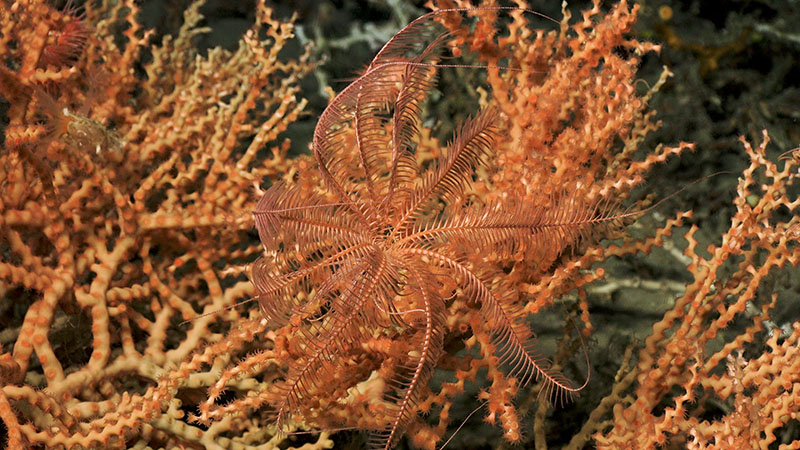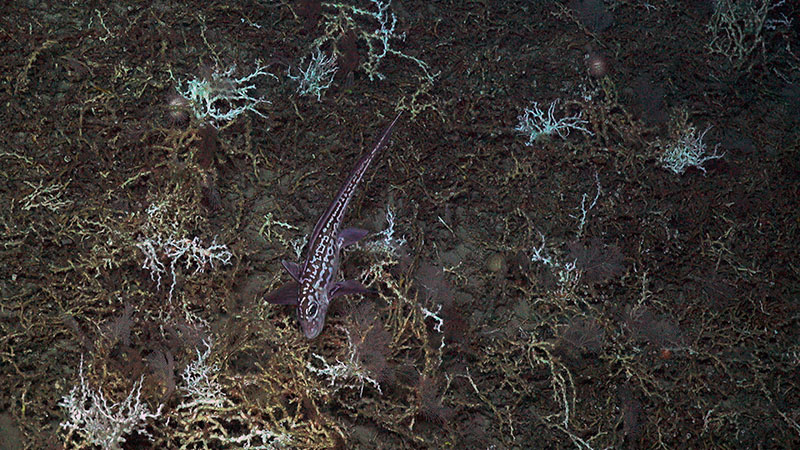
By Caitlin Adams, Web Coordinator, NOAA Office of Ocean Exploration and Research

ROV Jason is recovered onboard NOAA Ship Ron Brown using a specialized crane and winch system that travels with the ROV. Image courtesy of DEEP SEARCH 2019 - BOEM, USGS, NOAA. Download larger version (jpg, 5.2 MB).
This morning, remotely operated vehicle (ROV) Jason was successfully recovered after our first dive of DEEP SEARCH 2019. The Jason team had a smooth launch just after 9pm last night, and the ROV stayed in the water for over 12 hours exploring the deep-sea coral habitats of Richardson Hills. The Richardson Hills area is where we observed extensive Lophelia pertusa reefs on last year’s mission aboard R/V Atlantis. This year, we hope to spend a few days in the area, better characterizing and exploring the reef environment and its spatial extent.
Even though the majority of the first dive happened in the overnight hours, the DEEP SEARCH team was still abuzz with anticipation of what we might find, and many stayed up watching large portions of the dive, even if they weren’t scheduled to staff the control room during those hours. The control room has a seating area at the back of the room for extra observers, and the Jason team has also wired both the main lab and the computer lab to display the live feed of every dive, allowing more of the science team and the ship’s crew to follow along.

Josh Parris and Andrea Quattrini on their first shift as video and data loggers in the ROV control room. Image courtesy of DEEP SEARCH 2019 - BOEM, USGS, NOAA. Download larger version (jpg, 3.7 MB).
Those that were scheduled to stand watch stayed in the control room for four-hour shifts that we’ll maintain throughout the cruise. By keeping the same shift schedule each day, the hope is that we’ll be able to get on (relatively) regular sleep schedules, even though start and end time of each ROV dive will vary significantly each day. The dive lengths are variable for a number of factors such as dive objectives, weather conditions, sampling capacity of the basket, and the timing of other operations like lander deployment and CTD casts.
During every dive, the DEEP SEARCH team has three primary roles: watch lead, data logger, and video logger. The watch lead sits at the front of the control room, between the ROV navigator and pilot, and is responsible for directing the dive: what we see (they actually control the view of the 4K video, one of three primary cameras on the ROV), where we go, and what we collect. The data and video loggers sit one row behind them, keeping careful annotations of everything we see and sample, and ensuring that we’re capturing highlight videos and images.

The DEEP SEARCH team saw thriving Lophelia pertusa mounds like this one throughout Dive 1 at Richardson Hills. Image courtesy of Ivan Hurzeler and DEEP SEARCH 2019 - BOEM, USGS, NOAA, ROV Jason, ©Woods Hole Oceanographic Institution. Download larger version (jpg, 5.2 MB).

This crinoid was seen on Madrepora coral during Dive 1 at Richardson Hills. Image courtesy of Ivan Hurzeler and DEEP SEARCH 2019 - BOEM, USGS, NOAA, ROV Jason, ©Woods Hole Oceanographic Institution. Download larger version (jpg, 5.6 MB).

This Chimaera c.f. monstrosa was seen on a Lophelia pertusa mound at Richardson Hills during Dive 1. Image courtesy of Ivan Hurzeler and DEEP SEARCH 2019 - BOEM, USGS, NOAA, ROV Jason, ©Woods Hole Oceanographic Institution. Download larger version (jpg, 7 MB).
As this was our first dive, we know we all still have a lot to learn. These are brand new systems for much of the DEEP SEARCH team, and even those who have sailed with Jason before haven’t done so since its last major overhaul in 2016. By the end of our 22 days at sea, we’ll all be seasoned ROV professionals. And we’ll have a lot of stories to tell you along the way about what we find out here! Check back tomorrow for our first story about the science we’ll be conducting with ROV Jason.